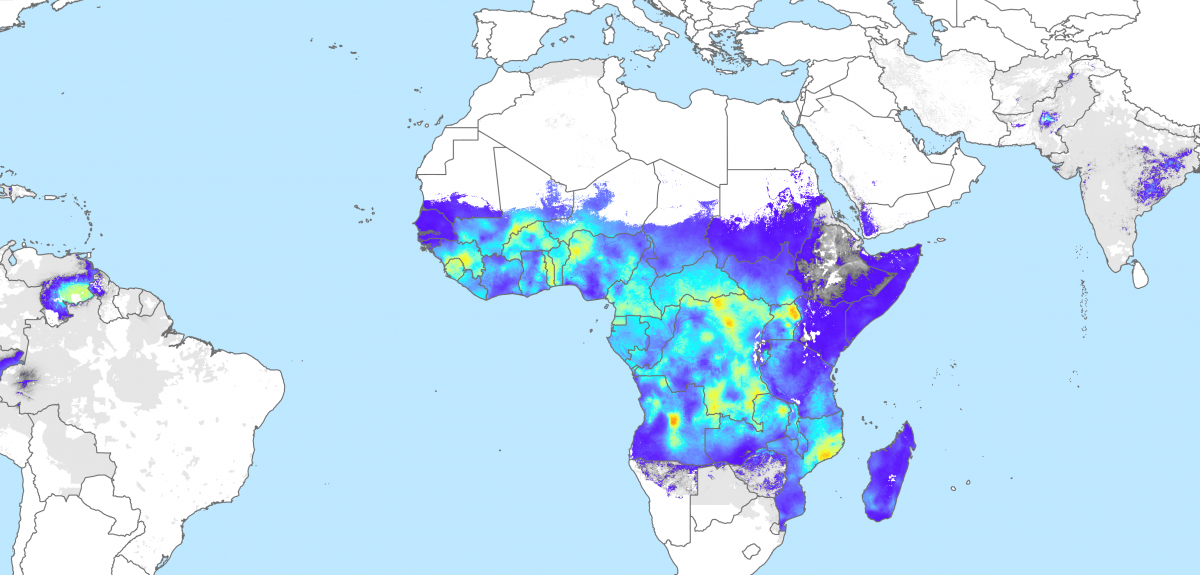
New maps could show how to beat malaria
New research published in The Lancet shows where the fight to defeat malaria is succeeding and where it has stalled. Two studies present the most comprehensive picture to date of the Plasmodium vivax and Plasmodium falciparum parasites, which cause the majority of the world’s malaria burden.
Previous global maps have focused on a single year. These studies chart the change over time from 2000 to 2017, revealing areas of progress and regions where the burden of malaria is still high or increasing. They also show the burden of malaria at a fine local geographic scale, allowing decision-makers to target interventions where the need is greatest.
The research, led by The Malaria Atlas Project (MAP) at Oxford University in collaboration with researchers at the Institute for Health Metrics and Evaluation (IHME), builds substantially on previous estimates of malaria burden by pulling in additional data sources and mapping trends over time. The results for 2017 make up the malaria estimates in the annual Global Burden of Disease Report produced by IHME and inform United Nations numbers relied on by the Global Fund and Ministries of Health.
Dr Katherine Battle of MAP, who led the work on P. vivax, said: “Vivax malaria causes significant health issues worldwide, yet until now little work had been done to accurately quantify its burden and how it varies globally. There are issues with both the diagnosis and treatment of P. vivax malaria that challenge control efforts, so up-to-date assessments of levels and trends of its global distribution are essential.
“Globally, our findings show a decrease in P. vivax from 24.5 million cases in 2000 to 14.3 million cases in 2017, a drop of around 42%. While this is good news, our work also shows that progress has plateaued in recent years, and in some places we are seeing an increase in cases since 2013.”
The work on P. falciparum was led by Dr Daniel Weiss of MAP. He said: “High-resolution maps of P. falciparum help to inform global policy and malaria control planning, programme implementation, and monitoring initiatives. Our work shows a 42.5% decrease in deaths and 27.9% decrease in incidence globally between 2005 and 2017.
“However, as we’ve seen for P. vivax, our maps show areas where progress against P. falciparum has recently stalled or reversed in recent years, underscoring the fragility of hard-won gains against malaria. It’s therefore critical for the international community to continue targeting resources where they can be most effective.”
 Spatial distribution of Plasmodium falciparum parasite rate (2017).
Spatial distribution of Plasmodium falciparum parasite rate (2017).Corresponding author Professor Peter Gething, Professor of Epidemiology at the University of Oxford and Director of MAP, added: “Understanding the distribution of malaria is crucial for fighting the disease. We’re constantly working to pull in more data and improve modelling strategies so that we can provide the best tools available for people around the world working to eradicate malaria.”
Professor Simon I. Hay is Director of the Local Burden of Disease project at IHME and founder of MAP. He said: “We can’t get complacent now on malaria eradication. There’s been a lot of progress, but in many areas there are still obstacles to overcome. These maps help make the case for continued commitment of resources and expertise to defeating a disease that has harmed and killed millions. With precise data, we can identify where support for prevention, diagnosis and treatment can make the biggest difference.”
The studies were funded by The Bill And Melinda Gates Foundation and The Wellcome Trust.
 New Year Honours 2026
New Year Honours 2026
 New study estimates NHS England spends 3% of its primary and secondary care budget on the health impacts of temperature
New study estimates NHS England spends 3% of its primary and secondary care budget on the health impacts of temperature
 International collaboration launches largest-ever therapeutics trial for patients hospitalised with dengue
International collaboration launches largest-ever therapeutics trial for patients hospitalised with dengue
 Oxford-built multi-agent assistant for cancer care to be piloted in collaboration with Microsoft
Oxford-built multi-agent assistant for cancer care to be piloted in collaboration with Microsoft